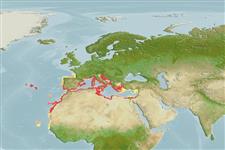Common names from other countries
Classification / Names / Names
Namen | Synonyme | Catalog of Fishes (gen., sp.) | ITIS | CoL | WoRMS
Environment: milieu / climate zone / depth range / distribution range
Ökologie
; tiefenbereich 4 - 100 m (Ref. 4). Subtropical, preferred 20°C (Ref. 107945); 46°N - 13°N, 32°W - 36°E (Ref. 4)
Eastern Atlantic and the Mediterranean: from Lisbon, Portugal to Senegal, and the Mediterranean.
Length at first maturity / Size / Gewicht / Alter
Maturity: Lm ? range ? - ? cm Max length : 45.0 cm TL Männchen/unbestimmt; (Ref. 4); common length : 36.0 cm TL Männchen/unbestimmt; (Ref. 441)
Carapace length: 12 cm. Occurs at depths between 4 and 100 m on rocky or sandy substrate. Feeds on mollusks, especially limpets (Patella sp.). Ovigerous females are observed from June to August (Ref. 4).
Life cycle and mating behavior
Geschlechtsreife | Fortpflanzung | Ablaichen | Eier | Fecundity | Larven
Ovigerous females from June to August (Ref. 4).
Holthuis, L.B. 1991. (Ref. 4)
IUCN Rote Liste Status (Ref. 130435)
CITES Status (Ref. 108899)
Not Evaluated
Not Evaluated
Nutzung durch Menschen
Fischereien: kommerziell
FAO - Fischereien: landings | FishSource | Sea Around Us
Tools
Internet Quellen
Estimates based on models
Preferred temperature
(Ref.
115969): 14.6 - 21.6, mean 18.7 (based on 246 cells).
Widerstandsfähigkeit
mittel, Verdopplung der Population dauert 1,4 - 4,4 Jahre. (K=0.2).
Verwundbarkeit
Low to moderate vulnerability (35 of 100).
